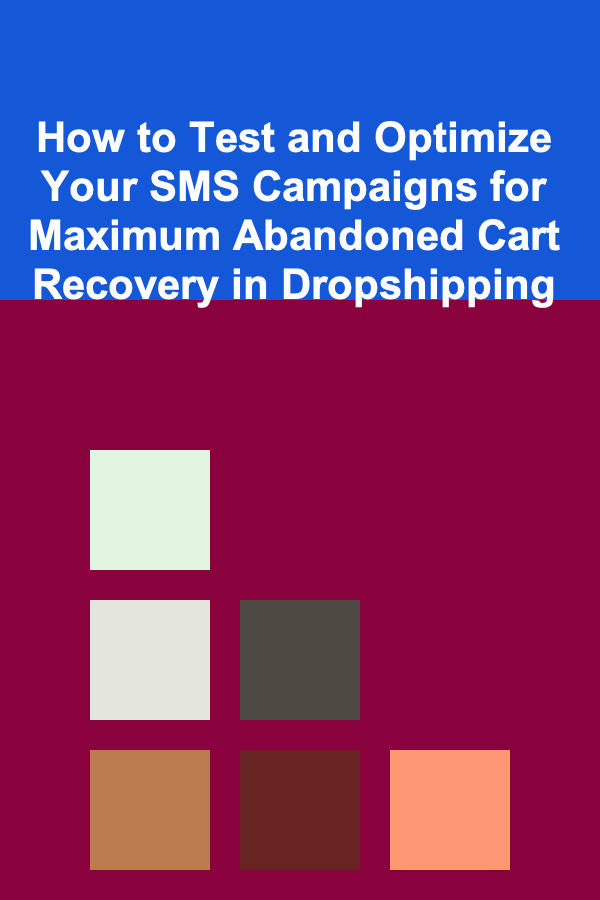
How to Test and Optimize Your SMS Campaigns for Maximum Abandoned Cart Recovery in Dropshipping
ebook include PDF & Audio bundle (Micro Guide)
$12.99$11.99
Limited Time Offer! Order within the next:

In the competitive world of dropshipping, abandoned carts can represent a significant loss in potential sales. According to various studies, nearly 70% of online shopping carts are abandoned before checkout. As an entrepreneur looking to scale your dropshipping business, recovering those lost sales should be a priority. One of the most effective tools in your arsenal for abandoned cart recovery is SMS marketing. With open rates of up to 98%, SMS is a powerful channel to re-engage customers who have left items in their carts.
However, just sending out generic abandoned cart messages won't guarantee success. To truly maximize the potential of SMS for cart recovery, you need to test and optimize your campaigns to ensure you're sending the right message at the right time. In this actionable guide, we will explore how to test and optimize your SMS campaigns to achieve the highest possible abandoned cart recovery rate.
Understand the Basics of Abandoned Cart SMS Campaigns
Before diving into testing and optimization, it's important to understand the core mechanics of an abandoned cart SMS campaign.
-
What is an abandoned cart SMS?
An abandoned cart SMS is a message sent to customers who have added items to their shopping cart but haven't completed the purchase. These messages typically include a reminder of the items left behind, a special discount, or other incentives to encourage the customer to complete the checkout process.
-
Why SMS?
SMS has an incredibly high open rate compared to email (which hovers around 20-30%). In fact, SMS messages are typically read within minutes of being received. This immediacy makes SMS one of the most effective channels for engaging customers who have shown interest in your products but need an extra push to complete their purchase.
Set Up Automated Abandoned Cart Recovery Messages
The first step in optimizing your SMS campaigns is ensuring that your abandoned cart recovery process is automated. This can be done through tools integrated with your eCommerce platform. Popular tools such as Klaviyo , Shopify SMS , and Postscript provide easy-to-use automation for abandoned cart recovery messages.
Here's how to set up the basics of your SMS automation:
-
Trigger the Campaign:
Configure your SMS tool to send a message after a customer leaves an item in their cart. Generally, waiting 1-2 hours before sending the first message works well, but you can experiment with different timeframes.
-
Personalize the Message:
Personalization is key to increasing conversion rates. Use dynamic fields to insert the customer's name, the items they left behind, and any special offers.
-
Set Follow-Up Messages:
Instead of sending a single message, create a sequence of 2-3 follow-up SMS messages spaced out over the next 24-48 hours. Remind the customer of the value they'll miss out on if they don't complete their purchase.
A/B Test Your SMS Content for Maximum Impact
Testing is crucial to improving your SMS campaign's effectiveness. A/B testing allows you to compare different versions of your SMS messages to see which one performs better. Here are some elements you can test:
a. Message Tone and Language
Experiment with the tone of your messages. Try a friendly, casual approach versus a more urgent, time-sensitive tone. For example:
- Friendly: "Hey [Name], we noticed you left something behind! Don't worry, your items are waiting for you. Come back and complete your order."
- Urgent: "Hey [Name], your cart is about to expire! Don't miss out on your [Product Name]. Complete your purchase now."
b. Call to Action (CTA)
Your call to action is the final nudge that encourages the customer to complete the purchase. Test different CTAs to see which one drives more conversions. Try variations such as:
- "Complete Your Purchase"
- "Claim Your Cart Now"
- "Finish Your Checkout"
- "Your [Product Name] is Waiting"
c. Discount and Incentives
Offering a discount is a common strategy for recovering abandoned carts. However, the type and amount of discount can greatly impact its effectiveness. Test various discount offers to see what works best, including:
- Percentage-based discounts (e.g., "10% off your order")
- Dollar-based discounts (e.g., "$5 off your next purchase")
- Free shipping (e.g., "Get free shipping on your order!")
- Special bonus gifts (e.g., "Free pet toy with your purchase")
d. Timing and Frequency
The timing of your SMS messages plays a big role in recovery rates. Experiment with different time intervals to determine when customers are most likely to respond. For instance:
- First SMS: Send 1 hour after abandonment.
- Second SMS: Send 24 hours after abandonment.
- Third SMS: Send 48 hours after abandonment (with an added incentive).
You can also test the frequency of follow-up messages. Do customers respond better to multiple messages over 48 hours or just one reminder?
e. Urgency and Scarcity
Incorporating a sense of urgency or scarcity into your SMS messages can increase conversion rates. Test messages that emphasize limited-time offers or low stock availability, such as:
- "Hurry! Only 3 left in stock!"
- "Last chance to get 10% off!"
- "Offer expires in 24 hours!"
Segment Your Audience for Targeted Campaigns
Not all customers are the same, and your SMS messages should reflect this. Segmenting your audience can lead to more targeted and effective campaigns. Some common segmentation strategies include:
-
First-time vs. Returning Customers
First-time buyers may need a different message compared to returning customers. For example, a first-time shopper might appreciate a special welcome discount, while a returning customer may simply need a reminder about their items.
-
High-Value Customers
Identify customers who make frequent or large purchases and offer them exclusive incentives. This could include offering a larger discount or free premium shipping for their abandoned cart.
-
Cart Value Segmentation
Customers with higher-value carts may respond better to a higher-value incentive. Segment based on cart value and tailor your offer to match.
Leverage Dynamic Product Recommendations
Personalization is a crucial factor in driving conversions. Beyond just reminding a customer of the items they left behind, you can increase the likelihood of recovery by showing them relevant, dynamic product recommendations.
For example, in your abandoned cart SMS, you can include:
- Suggestions for related products or accessories.
- Upsells (e.g., a bundle offer).
- Cross-sells (e.g., complementary items).
Example SMS:
"Hey [Name], we noticed you left behind your [Product Name]. How about pairing it with our [Complementary Product] for a perfect combo? Shop now and get [Discount] off!"
Analyze and Optimize Based on Metrics
Once you've set up your SMS campaigns and tested different elements, it's important to monitor performance and analyze the results. Key metrics to track include:
- Open Rate: The percentage of customers who open your SMS. If your open rates are low, you may need to tweak the content or timing of your messages.
- Click-Through Rate (CTR): The percentage of people who click on the link in your SMS. Low CTR suggests that your call to action or offer isn't compelling enough.
- Conversion Rate: The ultimate metric --- how many people complete the purchase after receiving your SMS.
- Unsubscribe Rate: Keep an eye on how many people unsubscribe from your SMS list after receiving abandoned cart reminders. High unsubscribe rates could indicate that your messages are too frequent or not perceived as valuable.
Use these insights to refine your campaign further. For example, if you see that certain offers or messages yield higher conversion rates, implement them into future campaigns. Similarly, if a particular timing strategy works best, roll it out across all your campaigns.
Automate and Scale Your Campaigns
Once you've found the optimal formula for your SMS abandoned cart recovery campaigns, it's time to scale. Use automation tools to set up different campaigns for various customer segments, automate your follow-up sequences, and track your performance in real-time.
You can also consider expanding your SMS efforts beyond abandoned carts by sending out post-purchase messages, product restock alerts, or promotions for seasonal sales.
Conclusion
Testing and optimizing your SMS campaigns for abandoned cart recovery is a continuous process that involves monitoring performance, experimenting with different tactics, and refining your strategy. By focusing on personalization, testing multiple elements like content and timing, and analyzing your results, you can significantly increase your cart recovery rates and drive more sales for your dropshipping business.
Remember, there's no one-size-fits-all approach --- what works for one store may not work for another. However, with the right testing and optimization, you'll be well on your way to recovering more abandoned carts and increasing revenue.

How to Choose the Best Lighting for a Home Office
Read More
How to Create a Functional Closet System for Small Spaces
Read More
How to Create a Holiday Atmosphere with Candles and Lanterns
Read More
How to Cut Costs on Groceries Without Compromising Quality
Read More
How to Enhance Your Home Theater with Soundproofing Techniques
Read More
How to Use Display Cases for Fragile Vintage Items
Read MoreOther Products

How to Choose the Best Lighting for a Home Office
Read More
How to Create a Functional Closet System for Small Spaces
Read More
How to Create a Holiday Atmosphere with Candles and Lanterns
Read More
How to Cut Costs on Groceries Without Compromising Quality
Read More
How to Enhance Your Home Theater with Soundproofing Techniques
Read More